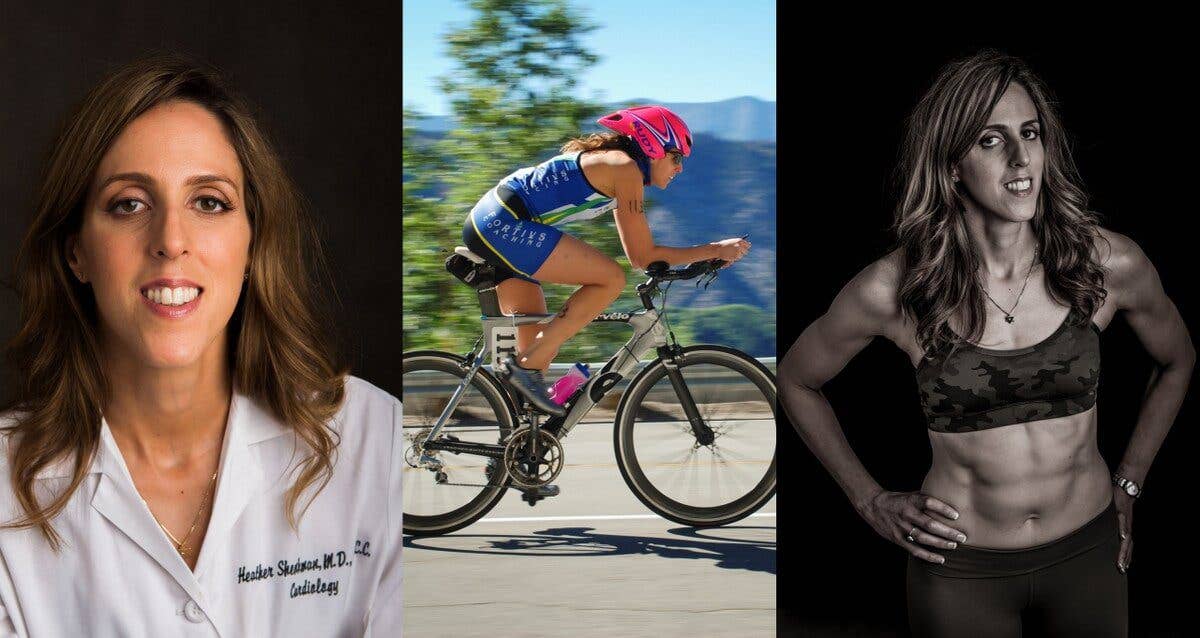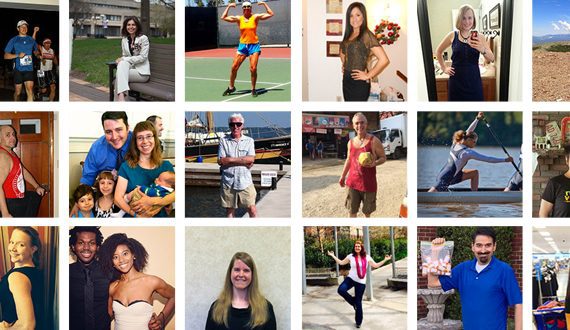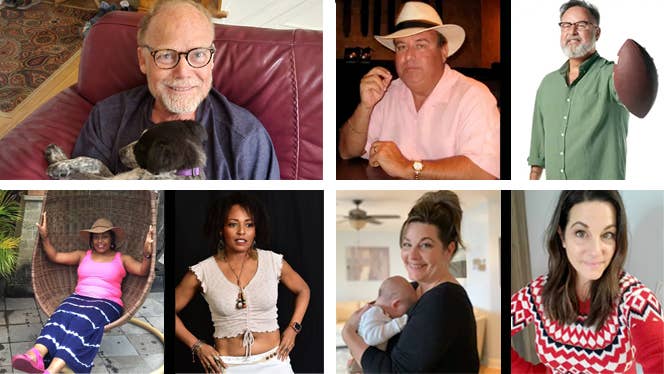
Meet Dr. Heather Shenkman, Ironman Triathlete and Vegan Cardiologist
By Heather Shenkman,
I haven’t always been an athlete, but I’ve been a vegetarian since I was about 16 years old. My brother was the first vegetarian of our family, which was an ethical decision he made at 10 years old after seeing chicken wings “dissected” in science class. He did everything he could do to convince the rest of our family to go vegetarian as well. A few years later, as he was preparing for his bar mitzvah, he told my parents he was not planning to wear tefillin, the leather straps that are a traditional part of the ceremony. My father made him a deal: if my brother wore the tefillin during the ceremony, then my father would become a vegetarian for one year. They both followed through and my father stayed a vegetarian. I became a vegetarian as well. Soon after, with no meat in the house, my mother followed. Since then, my entire immediate family has been vegetarian.
During my freshman year in college, I gained 27 pounds by eating too much pizza and ice cream and not doing any exercise. I had been a high school cheerleader, but I wasn’t really focused on health or fitness during college. It was during medical school when I started thinking about improving my own health and lifestyle. I wasn’t really receiving nutrition education in med school, but I did feel I should be living a healthier lifestyle if I was going to be instructing patients to do the same. I wanted to practice what I preached. I started to run, lift weights, and take cardio kickboxing classes. It was nothing serious or structured at first, but I found I enjoyed it. By exercising and making some better food choices, I was able to lose a good amount of my freshman weight gain. I decided I needed a goal, and during my residency, I ran my first marathon at 25 years old.
Becoming a Plant-Powered Triathlete
I was a vegetarian throughout college and medical school, but I became a vegan during my cardiology fellowship. I had originally become a vegetarian because of animal cruelty. However, as I learned more about the plight of farm animals, I felt like it was the right thing to do to also cut out dairy and eggs. In addition, in my own research as a cardiology fellow, I had read about the work that Drs. Esselstyn and Ornish had done to successfully reverse heart disease with a plant-based diet. So since then, about 11 years ago, I’ve been a vegan.
Throughout my 20’s, I kept on running for fitness, but I kept getting injured. During one period while I was sidelined, I took my piece-of-junk mountain bike to a bike shop. They were able to get it working, and I took up cycling. I also joined a local masters swim group and swam a couple of times a week. Finally, when I could run again, I was eager to put all three sports together. I found out that my spin teacher was a triathlete and triathlon coach. Off the cuff, I asked her to train me for a sprint triathlon. I did my first triathlon a couple months after I started training with her, and I had so much fun! This was in September of 2005, and my love for triathlons just blew up from there.
In July of 2010, I completed Ironman Lake Placid, which was my first Ironman-level triathlon (2.4 mile swim, 112-mile bicycle ride, 26.2 mile race). I competed internationally at the Maccabiah Games in the summer of 2013 and earned a bronze medal for the United States as a Masters (adult) level triathlete. Last summer in August of 2015, I completed Ironman Boulder. Five years older on a tough, high-altitude course, I still finished over an hour faster than my first Ironman. I like to have new challenges. Right now, I’m swimming a lot with a masters team, and am trying to perfect my butterfly stroke.
Training and Time Management
Even though I live alone with my two rescued greyhounds and have a busy job, I prepare most of my meals at home. I know that whatever I prepare at home is going to be far healthier than anything from a restaurant. I try to prep and stock my fridge so that it’s easy to grab something. For breakfast, I usually have oatmeal with fruit and/or a green smoothie blended in the Vitamix. For lunch and dinner, my staple meals are farmer’s market salads, rice and bean dishes, and sweet potatoes. Even for training, I like to stick with real food. I bring Medjool dates on very long runs or bike rides and snack on fruit (especially bananas) and nuts. Sometimes I do also have convenient foods like Larabars since they are timesavers and don’t have too many ingredients.
I exercise six days a week, usually doing two workouts per day. My typical weekday morning starts with Golden Road Aquatics, a master’s swim group, from 6-7AM. I shower at the pool and go straight to work. Then, in the evenings, I might go jogging, take a yoga class, or go to a class at Barry’s Boot Camp. Getting in my workouts can be challenging since I’m a busy cardiologist, but I schedule in the time to exercise. I look at my calendar and plan everything in advance so that I know what I am doing as I go into each week. I also do longer, more challenging workouts, like longer trail runs or bike rides, on the weekends.
My Patients: The Reason I Started Living a Healthy Lifestyle
I started exercising so that I wouldn’t be a hypocrite when I gave lifestyle advice to my patients. I had no idea it would become such a fulfilling, incredible part of my personal life. It was a happy surprise.
I encourage my patients to have healthy lifestyle habits and am tell them I would not ask them to do anything that I myself do not do. To help guide them in the right direction, I advise them to watch Forks Over Knives and frame a whole-food, plant-based diet as the healthiest choice. Since no other diet has been shown to reverse heart disease, I tell them that the closest they can come to this diet as possible is best for their heart.
I recognize that not every patient who walks in my office is going to walk out a vegan. In fact, most won't. My goal as a cardiologist is to provide my patients with the best information on how to improve their heart health and reduce their risk of cardiovascular events. What they do with that information is up to them. When I start talking to patients about diet, a common reaction is: “I'll never become a vegetarian!” I don't expect most of my patients (who eat meat, butter, and cheese at every meal) to give it up all at once. Instead, I talk about how their diet and lifestyle habits have led them to their present disease. We agree that years of animal products, fast food, junk food, lack of exercise, and smoking have all contributed to their current state of health. We also agree that in order to do better, some of those habits need to change.
For more resistant patients, I start out with simple and easy steps like: Eat more fruits and vegetables; eat less meat and dairy; walk for a few minutes every day. A plant-based diet is ideal, but some people need to start small with attainable goals. At the next visit, we take it a few steps further. On the other hand, I have patients who take on lifestyle change with vigor. They adopt a plant-based diet and start exercising. And without much effort, excess weight seems to come off. They tend to feel better as well. Of those motivated patients, I have not seen a single one of them have a recurrent cardiac event—not one has needed another stent or another bypass surgery.
Has a whole-food, plant-based diet impacted your life?
We would love to hear about it!
SHARE YOUR STORY
Free Download
Free 5-day meal plan!
Get a taste for healthy, fuss-free meal planning with this free five-day meal plan from Forks Meal Planner!
By providing your email address, you consent to receive newsletter emails from Forks Over Knives. We value your privacy and will keep your email address safe. You may unsubscribe from our emails at any time.

Join our mailing list
Get free recipes and the latest info on living a happy, healthy plant-based lifestyle.
By providing your email address, you consent to receive newsletter emails from Forks Over Knives. We value your privacy and will keep your email address safe. You may unsubscribe from our emails at any time.
